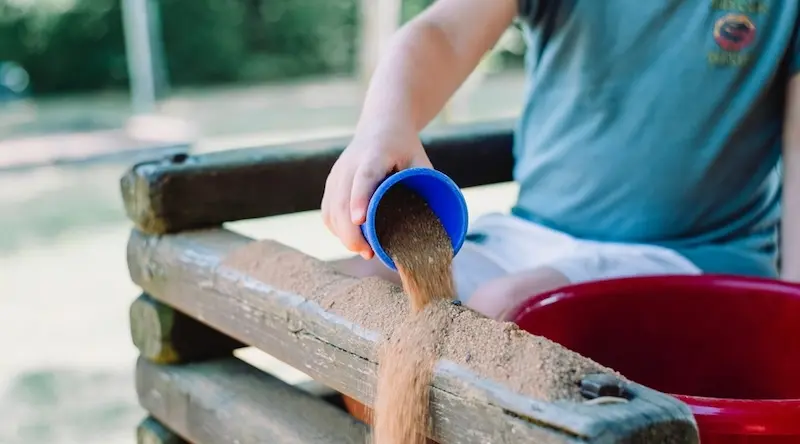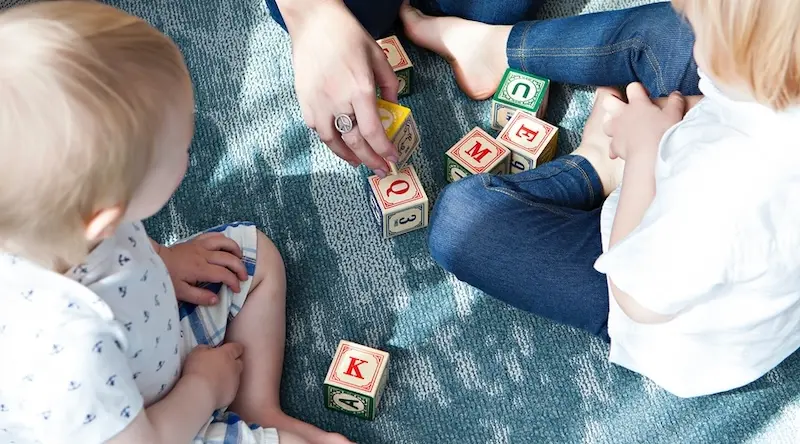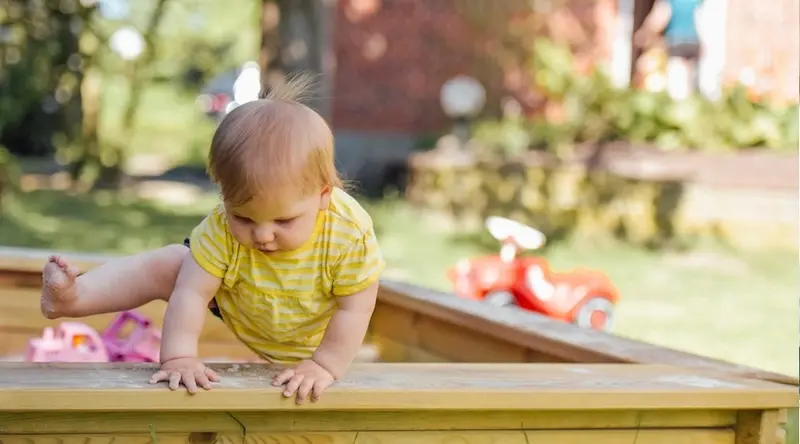settings
children
With Famly since
“Children are following schemas in play whether [educators] like it or not. People say things like ‘I don’t believe in schemas,’ and that’s fine. But they are always there.”
That’s Professor Cathy Nutbrown, of the School of Education at the University of Sheffield. Having begun her career as a teacher of young children, she learned from the leader and Early Years pioneer on schemas in play, Chris Athey. Since then, she has established doctoral programs in early education, reported on her own year-long independent government review and, in 2013, received the Nursery World Lifetime Achievement Award.
That’s why we jumped at the chance to speak with Cathy all about schemas in play, why they are so beneficial to keep in mind when supporting young children, and how educators can use them more effectively in their day-to-day. But first, what exactly are they?
Jean Piaget's schema play
Jean Piaget’s work influenced Chris Athey, who first noticed schemas as an observational tool in the 1980s. Following on from the work of Jean Piaget and after noting over 5000 observations, she started to notice certain fascinations in children appearing again and again.
These fascinations? That’s a schema.
“Athey calls it a pattern of repeatable actions,” explains Cathy. “That definition works for me, and I would add that the job of the [educator] is to spot that action and ask themselves Can I see that same action elsewhere?”

After that, it’s your role to decide what you offer the child to help advance this deep fascination. “It’s a tool,” says Cathy, “a way of thinking.”
These schemas, or fascinations, are generally patterns of movement, and often completely capture a child for a period of time. Athey’s original list included:
- Dynamic vertical
- Dynamic back and forth
- Dynamic circular
- Going over and under
- Going round a boundary
- Going through a boundary
- Containing and enveloping space
While many of the schemas identified afterwards sit within the patterns described by Athey, it can also be helpful for educators and caregivers to think of things like:
- Scattering
- Transporting
- Rotating
- Trajectory or Angles
- Connecting
Here’s an example from Cathy to get you started:
“At a nursery yesterday I noticed one particular child. Wherever I saw her, she was interested in things that were circular.
So she was tracing her finger around the edge of a circular plate, she went to the sand and she was making circular marks, she would pick up a book and trace her finger around the wheels on the vehicles.
The job of the practitioner would then be to tune into that and feed that. Think about what really interesting curriculum content they can feed this child so that they can extend that interest in a way that will broaden her experience.
That could be going outside, taking her to the park and making sure they go on the roundabout. It could be more circular songs and stories. The list is endless.”
- Professor Cathy Nutbrown, Professor of Education of the School of Education, University of Sheffield
How do children develop schematic interests?
These schemas, or even clusters of different schemas, shouldn’t be thought of as part of the child’s personality simply because they only last for a period of time.
While they can often dominate for some time, they can equally seem to fade as different schemas appear to take their place
“I’ve used the term ‘Dominant Schema’ to describe the patterns that very young children follow,” explains Cathy. “You might see times where for a few days or weeks a certain schema is the particular interest of a child, and then you might see other schemas come in and they mix together.”
That’s why it’s so key that you are constantly aware of schemas in play during your observation because they can change and transform into others, dissipate for a bit and come back.
“Ultimately you just have to follow the child,” says Cathy. “A schematic interest doesn’t mean they won’t become fascinated by something one day that strikes their interest that has nothing to do with the schemas. It could just be that a massive truck arrives outside the nursery and they just have to go and look at it. That’s not necessarily a schema, it could just be an interesting thing in life.”
“Everyone puts their own interpretation on working schematically with children. But for me, the things that most people can remember doing with their children are there because they’re the sort of things that are within us.
For example, when children are spun around in a circle by an adult, that feeling of going round is exhilarating. Almost every child has to do that. Many children need to walk on a higher wall with a parent holding their hand until one or other loses their nerve – and it’s normally the adult. Well, that’s about being up and the need to be up.”
- Professor Cathy Nutbrown, Professor of Education of the School of Education, University of Sheffield
Introducing the idea of "Form and Content"
During our discussion, Cathy explained the concept of ‘Form and Content’ – a great way of understanding the role practitioners have when it comes to schemas in play.
“The form of a child’s thinking, that’s the dynamic movements that we see as a schema,” says Cathy. “The content, that’s something that you can offer to nourish that form.”
(For our UK based customers - In EYFS terms, with schematic play we can see how the schema is carried by the Unique Child, and how it’s then up to you to offer Positive Relationships and Enabling Environments in order to provide rich learning experiences for them.)
“I might be watching a child, fascinated by those little wooden train sets that clip together with magnets,” says Cathy. “You could say that she’s interested in trains, or more interestingly you could say she’s interested in joining up. So I’ll make sure I’ve got the train set out, but also put out things that she can thread together, and other objects that she can connect. It’s a clue for the adult about what sort of things they should offer. Joining up is the form – the interest – and the content is, well, there the world really is your oyster.”

The importance of schemas in every child's learning
So now that we’ve covered a little bit about what schemas are, time to dive head first into why they’re so valuable to a child’s development.
1. Schemas force you to follow child interests
“When children are interested, they learn,” says Cathy. “If children are tuned in and absorbed then something is going on.”
This is one of the main benefits of schemas in play. Observing schematic interests and providing opportunities to extend them, is one of the best ways to truly respect and follow child interests. And if we’re not following child interests, then what are we doing? Forcing children to do something they’re not interested in? That doesn’t sound much like quality early years learning at all.

2. Schemas offer us a new way to look at children's behaviour
“Many actions associated with schemas might seem mischievous,” says Cathy. “But actually it’s just children doing things with what they’ve got. If you don’t give them the sort of open-ended materials they can manipulate as they like, then they’ll just do that with something else.”
Moving things, throwing toys, scattering items, hiding valuable possessions – it can all just seem like the actions of a naughty child to practitioners or parents who don’t fully understand the way schemas affect a child’s behaviour.
But if you can see that the child throwing his toys is really exploring trajectory? Well, then you can provide resources that allow the child to explore that interest, rather than scolding them for throwing the wrong thing.
“In Chris Athey’s book, there’s an example of a child wrapping her mother’s shoes in newspaper and putting them in the bin.
That could be seen as really bad behaviour and her mother could have been furious. But instead, because she was tuned into her child and thought ‘I bet she’s put them somewhere’, she found them in the bin before bin day.
Now I’m not saying you should encourage children to wrap up their mother’s shoes and put them in the bin, but it should help you to understand. So if you see they’re really into wrapping things up and hiding them then you need lots of things like suitcases and handbags that stuff can go inside of legitimately.”
- Professor Cathy Nutbrown, Professor of Education of the School of Education, University of Sheffield
3. Schematic play underpins later skills
When children explore their world through schemas in play, they also gain an understanding of how these different forms of movement might start to come together. It is this combination that helps them to form many of the skills they need for later life, according to Cathy.
“Ultimately schemas lead, for example, to writing,” explains Cathy, “because if you have children interested in round and round, up and down and they themselves have moved like that? Well then ultimately you have children who have internalised the feeling of round and round, and up and down.”
If we’re to agree with Piaget, then thought is this type of internalised action, and by making these actions, they are giving themselves the building blocks to become writers. “Eventually a child can represent that when someone offers them a felt-tip,” Cathy concludes.
“What’s more, if you have a rich array of things that they can explore their interest with, then you will naturally get into mathematics and science,” she continues. “If you’re trying to put a number of things in a small container and it’s full, then you’re getting the concept of fullness. Concepts of volume and capacity are taught more formally later, but these are the early – and fun – beginnings of those discoveries.”
“A good thing for nurseries to understand in terms of writing is that if you see that children are drawing sunshines and spiders, bicycle wheels with spokes, and all the hands they draw have lots of fingers – then you know that they have all the marks they need to make the English alphabet.
Putting a diagonal line through a circle in this way is really hard for children. This relates to schemas because the physical doing of those dynamic movements eventually (if Piaget’s thinking is worth paying attention to) means that they internalise that movement and they can represent those abstract things in their head. Then they can make those marks.”
- Professor Cathy Nutbrown, Professor of Education of the School of Education, University of Sheffield
How can Early Years educators use schemas?
So now that we understand why schemas are so valuable, time to move onto some actionable ideas to make better use of them in your center. And much like everything else, it starts with quality observation…
1. Observation of schematic play
“We spot schemas in children by watching what they are doing,” states Cathy. Quite simple right?
But we all know that quality observation isn’t always that easy. So when it comes to schemas, what should you look out for? “A lot of it is about movement,” answers Cathy, “so it’s really about tuning into and watching the child for those movements and then thinking, What can I ask parents to find out if there’s a match between their action and their thinking?”
Educators clearly need to know what they're looking for, and a good understanding of the different types of schemas can help, but they also need the time and space to observe children in order to recognize what schemas the child is following.
Once they’ve got an idea, then it’s just about giving their ideas a go. “Let’s say that you think you spot some “Over and Under” movements in a child,” says Cathy. “If you feel tuned in and you’ve spotted some good opportunities for further exploration – give it a go. Read them Billy Goats Gruff. Provide things to make bridges with. Emphasise over and under on the climbing frame. And then see how they respond.”

2. Open-ended resources to facilitate schematic play
A theme that kept on returning through our discussion was the idea of open-ended resources.
When you have open-ended resources, children with different schematic interests can all play at once. That’s when you’ll truly see schematic interests shine.
“If things are very fixed – let’s take a jigsaw table with pieces which can only fit together in one way – then you’ll see fewer examples of schemas, because the children will be struggling to find ways of doing what they want,” says Cathy. “But you might still find the jigsaw pieces in a handbag.”
“A nursery I went to the other day had loads and loads of old milk crates that were light enough for children to stack. If they fell, they were plastic and they didn’t do much harm. But they could manipulate them – that’s what was important.
At one point it was even a house with a doorway, with something across the door because for some children, making that barrier is important too.”
- Professor Cathy Nutbrown, Professor of Education of the School of Education, University of Sheffield
3. Support young children with language
“Schematic play is a great opportunity for language development,” says Cathy, “so long as you have adults who are linking in and matching their language with what the children are actually doing – not just what they think they’re doing.”
Imagine a child is building a tower, an action closely linked with the vertical schema. Then practitioners need to make sure they’re using language like ‘You’re building up’ or ‘You’ve put another one on top” rather than labelling the play with concepts like ‘Are you building a tower?’ or ‘Oh wow you’re a giant’.
“If you give the language of form to children, then it matches what they’re thinking and you have an opportunity to extend language that they might not have,” says Cathy. “But if you say “Oh are you the King of the castle?”, then that might not mean anything to the child at all. You’ve imposed an adult set of thoughts on them. So they’ll either smile politely or ignore you completely. But if you get the words right as a match then you might even hear them back, and that’s the way children can build language.”
4. Provide opportunities for extending play and learning
Once you’ve spotted an interest or schema in play, it’s all about providing opportunities to extend that interest.
It could be providing more resources, taking that interest into the outside world, or giving the child the right language associated with it. Take up and down for instance.
“If they like up and down, rather than keeping it confined to the climbing frame, think about the shopping centre,” says Cathy. “Is there a glass lift? Is there an escalator? How can you help children to see the vastness of, say, a crane? It’s about how you extend that core idea with more ambitious things in order to open a child’s eyes to more possibilities.”

5. Involve parents in understanding schematic play
Giving parents an understanding of schemas in play is one of the best ways you can help them to think about the learning environment at home.
“When talking with parents, these things are like light bulbs,” says Cathy, with a laugh. “Things that might seem like naughty behaviours, throwing the teddy down the stairs, pushing things, using household items to do unorthodox things – parents get that very quickly.”
By explaining schemas to parents, you’re giving words and developmental understanding of something they instinctively know already. They’ll understand certain interests and fascinations better, and along the way gain even more respect for your team as knowledgeable practitioners.
6. Notice when children are pushing boundaries
One final piece of advice Cathy gave us was to watch out for children pushing boundaries. If they’re pushing the boundaries of your resources then it’s a great time to observe – so long as you’re not needed on urgent clean-up.
Why? Because when children push the boundaries of their resources, they are telling you what sort of resources they really require. Then you can provide them with what they need to follow their interests.
For example, you might have children who are just not quite content with filling a single jug in a water tray. They might start exploring the sinks and the bathrooms, and you’ll suddenly find yourself with some flooded bathrooms on your hands.
“The thing here is that you need to realise, What I’ve provided is not enough, so I have to think what richer content I can provide,” explains Cathy. So it might be having large buckets and a water trug outside so that children can fill and overfill to their heart’s content. In the end, it’s just going to water the garden.”
Further Reading
- Threads of Thinking – Schemas and Young Children’s Learning by Cathy Nutbrown – Cathy’s own authoritative book on the subject of schemas in play is written for early years practitioners. It contains detailed examples and easy explanations for issues you might face during the process.
- Schematic Pedagogy – Supporting One Child’s Learning At Home and In A Group by Frances Atherton and Cathy Nutbrown – This free downloadable paper follows the journey of one child, Annie, and how her schematic play interests can be identified and extended.
- Extending Thought in Young Children by Chris Athey – This is the fully revised version of Athey’s original classic work and features plenty of valuable insight on schematic play.
- Understanding Schemas in Young Children: Again! Again! Edited by Sally Featherstone – This brilliant guide written by a number of key figures and edited by Sally Featherstone features lots of examples and clear guidance to take your understanding of schemas in play to the next level.
- Understanding Schemas and Young Children by Cathy Nutbrown and Frances Atherton – This book from Cathy’s work with Frances Atherton focuses on children under 3 specifically, and comes with plenty of rich observational examples and ideas.
- The Pen Green Centre – The Pen Green Centre’s website has tens of articles about all different aspects of schemas. Just type schemas into the search bar in the top right-hand corner to see all of their work.
- Patterns of Behaviour by Frances Atherton – This brief article helps to give a really good understanding of schemas by exploring one schema in particular – Containing and enveloping.
Professor Cathy Nutbrown of the School of Education at the University of Sheffield began her career as a teacher of young children and has since worked in a range of settings and roles with children, parents, teachers, and other early childhood educators.
In June 2012 she reported on her year-long independent review for the government on early years and childcare qualifications (The Nutbrown Review). In 2013 she won the Economic and Social Research Council prize for Research with Outstanding Impact on Society in recognition of her Raising Early Achievement in Literacy (REAL) research, and in the same year, she was honoured to receive the Nursery World Lifetime Achievement Award.
The big ideas
Top tips from Alphabet House
Get top tips from a setting just like yours. Hear from Alphabet House on why and how they use Famly - and why they’ve never looked back.
Read their story









